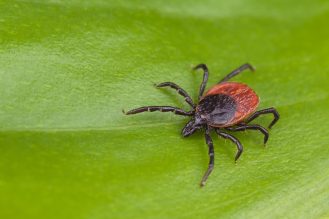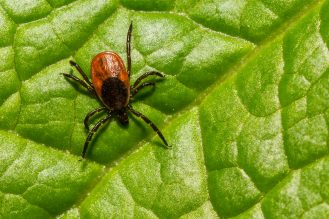Guard yourself against tick season: helpful safety measures for you and your pets
Tick season is underway. With rising temperatures, ensure to check yourself and pets for ticks regularly.
Environment | May 17, 2024
Tick season is in full swing with the warm weather here to stay, it’s important to check yourself and pets regularly for ticks.
A tick is a small, blood-sucking parasite closely related to a spider. Ticks are crawlers. They don’t jump or fly but quietly wait on long grass or branches to crawl on an unsuspecting person or animal to bite. It is that painless bite that can lead to health concerns for you and your pet. Ticks are often hard to see because they are less than three millimetres or as small as the head of a pin.
Black-legged ticks
Although ticks are mostly active in spring and summer, they can survive when the temperature is above freezing. There are many varieties of ticks in Ontario, but the one of greatest concern in Ontario is the black-legged tick (also known as the deer tick). Black-legged ticks can carry bacteria, parasites and viruses that can be transmitted to humans through a bite. The most common disease transmitted by ticks is Lyme disease which can have serious health implications. The black-legged tick can also transmit other diseases of public health significance including Anaplasmosis, Babesiosis and Powassan.
Although black-legged ticks can be found in Mississauga, they are not common. Residents are more likely to encounter the American dog tick which does not transmit Lyme disease.
Preventative measures: protecting yourself from ticks and Lyme disease
Here are some tips to help ensure you, your family and your furry friends stay safe during tick season.
- Wear long-sleeved shirts that fit tightly around the wrist and long-legged pants tucked into socks or shoes or boots.
- Wear light-coloured clothing to make it easier to see ticks on clothing, especially socks.
- Roll yourself with a lint roller after being outdoors to pick up any ticks that may be on clothing.
- When hiking or walking in tall grass or brush, stay in the centre of cleared trails as much as possible.
- Avoid brushing up against vegetation where ticks may be waiting.
- Check your clothing for ticks. Take a lint roller and roll it on your clothes, then tumble dry clothes in a dryer on high heat for 10 minutes to kill ticks on dry clothing after you come indoors.
- If the clothes are damp, additional time may be needed.
- If the clothes require washing first, hot water is recommended. Cold and medium temperature water will not kill ticks.
- Check your body for ticks and shower soon after being outdoors. Check under your arms, in and around your ears, inside the belly button, behind the knees, near your ankles, around the waist, and especially in your hair.
Protecting your pet from ticks and Lyme disease
- Avoid areas known to have high tick populations.
- Speak to your veterinarian about tick prevention and the risks in your area.
- In the event you’re walking your dog in heavily wooded areas, a six-foot leash will help minimize contact between ticks and your pet.
- Conduct regular visual and physical examinations of your pet after being outdoors.
- Minimize the presence of ticks in your yard by keeping it well-maintained with mowing your lawn regularly, removing tall weeds, and clearing out any brush or leaf litter.
- Consider creating a barrier of wood chips or gravel between your lawn and wooded areas to restrict tick migration.
Tick bites
If you or your pet get bitten by a tick, it’s important to remove it as soon as possible. Use fine-tipped tweezers to grasp the tick as close to the skin’s surface as possible. Pull upward with steady, even pressure. After removal, clean the bite area and your hands with rubbing alcohol, an iodine scrub, or soap and water.
If a black-legged tick has bitten you, you may be at risk of developing Lyme disease. Talk to your health care provider or ask your pharmacist about antibiotic medication to prevent the development of Lyme disease.
Learn how Public Health Ontario is monitoring Lyme disease.
Report ticks
Peel Public Health conducts active surveillance throughout Peel Region but no longer accepts tick submissions for identification. Public Health Laboratories will accept submissions of ticks found on humans but only from healthcare providers for species identification only.
Ticks are not tested for pathogens and the turnaround time is approximately three weeks.
Alternatively, if you have a tick that you would like to be identified, you can take a photo and submit it to etick.ca, a free online tick identification service. The turnaround time is 24-48 hours.
Get answers to questions about tick submissions and testing.
Ticks and climate change
With climate warming and environmental changes, ticks are becoming more common in Canada with longer, warmer seasons. Hotter summers and milder winters are allowing ticks to extend their survival, growth and reproduction. They are also establishing themselves in new and existing areas, especially around southern Ontario. The extended summer also means ticks are more active, increasing the chances of more human-tick contact.
As tick season approaches, it’s essential for all of us to stay alert and take preventive measures to safeguard ourselves and our pets, aiming to decrease the chances of tick bites within our community.
Tags
Media contact
City of Mississauga Media Relations
media@mississauga.ca
905-615-3200, ext. 5232
TTY: 905-896-5151



